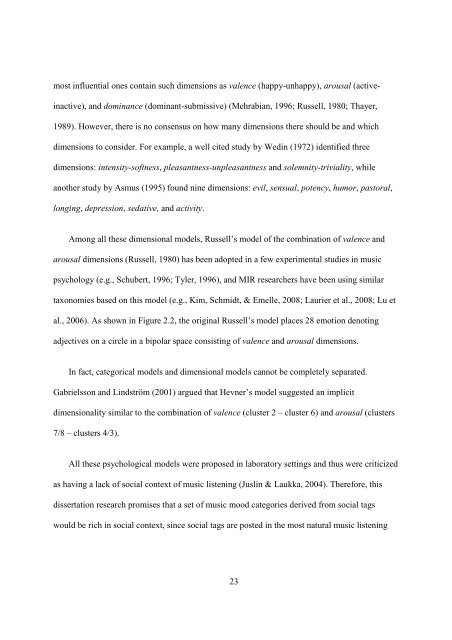improving music mood classification using lyrics, audio and social tags
improving music mood classification using lyrics, audio and social tags
improving music mood classification using lyrics, audio and social tags
You also want an ePaper? Increase the reach of your titles
YUMPU automatically turns print PDFs into web optimized ePapers that Google loves.
most influential ones contain such dimensions as valence (happy-unhappy), arousal (activeinactive),<br />
<strong>and</strong> dominance (dominant-submissive) (Mehrabian, 1996; Russell, 1980; Thayer,<br />
1989). However, there is no consensus on how many dimensions there should be <strong>and</strong> which<br />
dimensions to consider. For example, a well cited study by Wedin (1972) identified three<br />
dimensions: intensity-softness, pleasantness-unpleasantness <strong>and</strong> solemnity-triviality, while<br />
another study by Asmus (1995) found nine dimensions: evil, sensual, potency, humor, pastoral,<br />
longing, depression, sedative, <strong>and</strong> activity.<br />
Among all these dimensional models, Russell’s model of the combination of valence <strong>and</strong><br />
arousal dimensions (Russell, 1980) has been adopted in a few experimental studies in <strong>music</strong><br />
psychology (e.g., Schubert, 1996; Tyler, 1996), <strong>and</strong> MIR researchers have been <strong>using</strong> similar<br />
taxonomies based on this model (e.g., Kim, Schmidt, & Emelle, 2008; Laurier et al., 2008; Lu et<br />
al., 2006). As shown in Figure 2.2, the original Russell’s model places 28 emotion denoting<br />
adjectives on a circle in a bipolar space consisting of valence <strong>and</strong> arousal dimensions.<br />
In fact, categorical models <strong>and</strong> dimensional models cannot be completely separated.<br />
Gabrielsson <strong>and</strong> Lindström (2001) argued that Hevner’s model suggested an implicit<br />
dimensionality similar to the combination of valence (cluster 2 – cluster 6) <strong>and</strong> arousal (clusters<br />
7/8 – clusters 4/3).<br />
All these psychological models were proposed in laboratory settings <strong>and</strong> thus were criticized<br />
as having a lack of <strong>social</strong> context of <strong>music</strong> listening (Juslin & Laukka, 2004). Therefore, this<br />
dissertation research promises that a set of <strong>music</strong> <strong>mood</strong> categories derived from <strong>social</strong> <strong>tags</strong><br />
would be rich in <strong>social</strong> context, since <strong>social</strong> <strong>tags</strong> are posted in the most natural <strong>music</strong> listening<br />
23
















